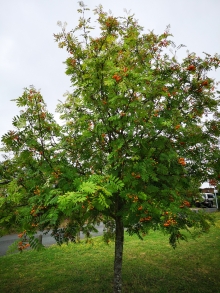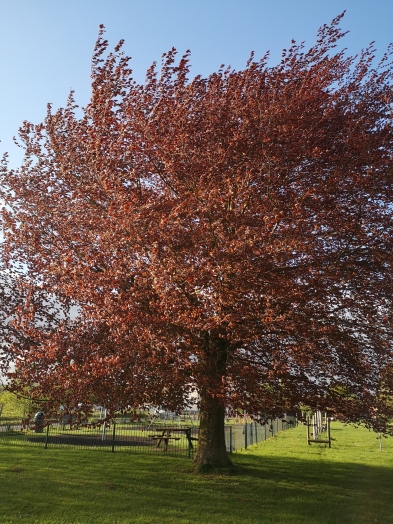LOCAL LINKS
Read LIFELINE
here (our village newsletter) and
the East Farleigh Grapevine!
West Farleigh Sports Club for football, cricket & great parties
All Saints church services...
...and hall for hire
Loads of useful contacts
Links along the valley: parishes, churches & halls
Follow us
on Facebook
Subscribe to our events email!
Kent Men of The Trees (KMOTT) - Trees in the Village Competition 2019
Each year, villages throughout Kent are invited to enter a competition whereby their trees can be inspected by an experienced judge who will award points based on the following criteria:
- The quality of trees in public places and in private gardens
- The condition of any commemorative or specially chosen trees
- Evidence of new planting within the village area
- General care of trees within the village boundary
- The response to suggestions made by the judge during previous visits
The competition is run by the Kent Men of The Trees (KMOTT) who are a Kent based charity, and have been established since around 1959, the general aim of the organisation is to enhance the love of trees and to encourage everyone to plant and protect trees in Kent and, in the words of their founder, to be ‘a society of tree lovers working to create a universal tree sense and encourage all to plant, protect and love trees everywhere’. This is something I can totally connect with.

Above - View from the Tickled Trout towards the Medway Valley
After a couple of false starts I finally caught up with Brian who was our judge for today. I had a route & itinerary planned which started at the Tickled Trout, took in the view towards the Medway valley, and then moved over to the grounds of Smiths Hall which took in such delights as the American Arboretum, the English Woodland, the Meadow and a good deal of others.

Above - View from Smiths Hall grounds towards Teston

Above - A snippet of the American Arboretum, Smiths Hall


Small selection from the delightful grounds at Smiths Hall

Next it was over to Ewell Manor, courtesy of Peter and Catherine Meddemmen. According to my records it was the first time access to the Village Manor had been successfully negotiated and the judge, along with his colleagues back in Canterbury were suitably thrilled with this as well as the earlier magical opportunity to look around the grounds of Smiths Hall.



Wellingtonia - Ewell Manor
Beech, c400 years - Ewell Manor
Lime - Ewell Manor
Ewell Manor has a great number of trees, among them some rather spectacular ones including a grand Wellingtonia (Sequoiadendron giganteum), and a fabulous Beech (Fagus Genus) - which is an especially lovely example, thought to be at least 400 years old, which makes it older than our very own 'Handel's Oak, so named as it was thought to be planted in the same year Handel was born (1686) located on the West Farleigh side of Teston Bridge (incidently the Ewell Manor Beech also comes with it's very own sapling which itself is thought to be around 200 years!).
Amongst the masses there are a couple of huge beautiful Lime's (Tilia x europaea), a Cypress (Taxodium Genus) and a Western Red Ceder.
Next stop was the Parkland, adjacent to Ewell Lane (opposite Ewell Manor), through the horse fields heading towards Charlton Lane, with its lovely collection of well-kept trees and of course its magnificent collection of Chestnuts, Oaks and Beeches.

Above - The 'Parkland'
A quick stroll up through The Hollow saw us take in the Village Green along with its extensions, and lovely selection of trees.



Variety of trees on the extensions to the Village Green, including a SweetGum (Liquidamber styraciflua)

Village Green - The fabulous Copper Beech

Main Green & Green extension:
- Field Maple (Acer campestre)
- Lime (Tilia x europaea)
- Copper Beech (Fagus sylvatica purpurea)
- Holm Oak (Quercus ilex)
- Red Filbert (Corylus maxima)
- Sweet Gum (Liquidamber styraciflua)
- Cherry Tree (Prunus)
The Good Intent:
- Walnut Tree (Juglans regia)
- Honey-locust (Gleditsia triacanthos)
- Copper Beech (Fagus sylvatica purpurea)
Next up into the absolutely lovely secret haven of Leslie & Brian Cushing, who had also agreed to allow us (with a small bit of arm twisting, no really I jest) into their own perfectly formed oasis of tree heaven, with notable exhibits including but by no means ending with, an Indian Bean tree (Catalpa bignonioides), an American Red Oak (Quercus rubra), a Judas Tree (Cercis siliquastrum and Monkey Puzzle (Araucaria araucana) which incidentally Brian our judge thought was one of the best specimens he has ever seen! Well done Leslie!

Unfortunately, the photographic evidence of the Cushing’s private gardens has been compromised and pending investigation we will have to make do with a common list of the fine specimens that wowed the Kent Men of the Trees judge. My apologies to Brian and Leslie, but no matter, I will make recompense with Cherry Plum juice, which I'm told mixes rather well with Gin!
- Indian Bean (Catalpa bignonioides)
- American Red Oak (Quercus rubra)
- Silver Maple (Acer saccharinum)
- Column Birch (Betula pendula 'Fastigiata'…?)
- White Poplar (Populus alba)
- Beech (Fagus Genus)
- Judas Tree (Cercis siliquastrum)
- Maple (Acer palmatum)
- Monkey Puzzle (Araucaria araucana)
- Kentish Gooseberry Apple (Malus domestica)
Monkey Puzzle - 'Best specimen ever seen'!
After a brief lunch at the Good Intent, during which I brought our good Judge up to speed with the recently formed WFWL Society (West Farleigh Walnut Liqueur Society) and again he was suitably impressed with the community spirit, excuse the pun.... For more details head up to the top of Charlton Lane and get the latest from Pauline, Brian or Leslie.
By now we were well past our allotted 2.5hrs, but this was no obstacle, at this stage I felt Brian was totally bought into our village and trees, so onwards and upwards it was, heading along Charlton Lane, past the newly planted English Hedgerow (thanks to Dandelion Time), towards Lower Road, onto Church Lane and the Churchyard.
The Churchyard was looking immaculate with its seven Old English Yews (Taxus baccata) c.1714 - 1721, all free from Ivy and Elder, and make for a very pleasant experience, not forgetting the Lawson’s Cypress at the North end, with its lush green / golden foliage and the Irish Golden Yews (Taxus baccata aurea group) clipped to perfection lining the path to the Church entrance. The overall impression I received from Brian was that he was suitably impressed with the appearance of the Churchyard and the continued effort put in to maintain the current high standards.

Above and right, further examples of our great Yews


Above - Entrance to All Saints Church guarded by one of the 'magnificent seven' Yews


Above, a Lawson’s Cypress at the North end of the Churchyard, with it’s lush green / golden foliage
Irish Golden Yews (Taxus baccata aurea group) trimmed to perfection!
Swiftly onto the Cricket Ground which as usual was a joy to experience, with its Beeches, Horse Chestnuts and Ash Trees amongst others lining the boundary. It is worth pointing out that you can also find the following on the boundary, a Sweet Gum (Liquidambar styraciflua), Norway Maple (Acer platanoides), and hidden behind the Pavilion is a Raoul or Rouli tree (Nothofagus, Southern Beeches?) and in the far corner of the cricket ground Alders (Alnus cordata).


Mature Oak on the Cricket ground, similar to the old Lime at the St Lawrence County Ground, Canterbury
This magnificant mature Sweet Chestnut resides behind the Cricket Pavillion, overseeing his mighty kingdom!

View of the Pavillion Boundary

Above - Game on and Tree on!
By now we were fast running out of time, with the following still on our itinerary; the Handel Oak, an English Oak (Quercus robur) c.1686 on the corner of Teston Bridge and Teston Lane, and head back up Teston Lane, crossing over into Mill Lane one can see the line of Crack Willows (Salix fragilis) alongside the riverbank and further along Mill Lane, around the corner you start to come across the Ancient Oaks whose breadth of trunk are unbelievable.

Above - Handel Oak c.1686


Above - Crack Willows, River Medway
Above - Ancient Oak, Mill Lane
We returned to the Tickled Trout for some well-earned rest and refreshment (by the time I had returned home we had covered just over 15 kilometres). In summary the day went very well, and our village tour was exceptionally well received by our Judge, Brian was suitably impressed with the planning, itinerary, and mix of private and community spaces that were included in the walk.
Our Judge would be happy to recommend that several trees be gifted to West Farleigh in recognition of the effort put into the trees in the village competition. We discussed location of new plantings in detail and agreed that the Lower Road Lay-by could easily accommodate another new Silver Lime (Tilia Brabant), and the Village Green potentially a further four trees of varying ages to enhance the age range of the tree ages. Indeed, if we were to recommend any further new planting sites and species, then they would happily consider this. I'd be happy to consider any suggestions / ideas in respect of these and any new plantings.
Despite being time consuming and sometimes frustrating, all told I had a fantastic time putting the route & itinerary together and thoroughly enjoyed giving our esteemed judge a tour of our wonderful village and it very own tree population!
I'd like to thank again, everyone who has helped make this a successful tour de force of West Farleigh, especially, Stephen Norman, Peter & Cathryn Meddemmen, Leslie & Brian Cushing, The Tickled Trout and the Good Intent.
In case you are wondering, at the time of writing this article we are currently awaiting feedback from the Kent Men of the Trees Competition Judges. Will keep you posted.
Hope you enjoyed this update!
Ed Boyd,
Volunteer Tree Warden for the village of West Farleigh, Kent
Contact: edboyd.2@hotmail.com






